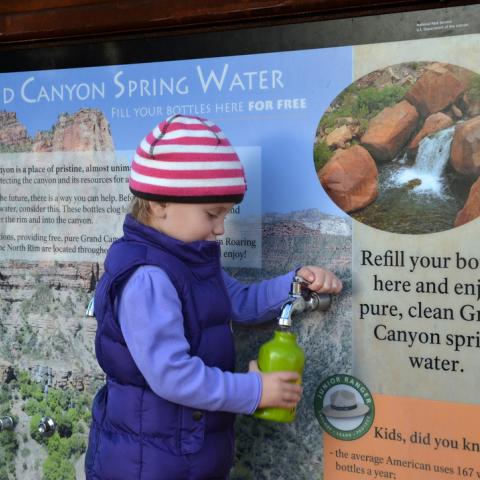
Another break in Grand Canyon National Park's main water pipeline means water conservation measures on the North Rim/NPS file
Yet another break in Grand Canyon National Park's main water pipeline has prompted officials to institute water conservation measures on the North Rim of the park. The break, the sixth this year, occurred when rockslides spurred by recent wintry weather cracked the pipeline that leads from Roaring Springs, the park's main water source, to the North Rim faciltiies.
Due to continued poor weather and difficulty reaching the pipeline break, crews will not begin repairs until Saturday, a park release said.
North Rim facilities remain open with water limitations for some services. The National Park Service campground will operate normally with available potable drinking water and portable toilets. The public laundry and public shower facilities will be closed. All other facilities are open, with the addition of portable toilets in place of public flush toilet facilities.
The Grand Canyon Lodge North Rim will continue to operate its overnight accommodations and day use facilities with water conservation measures in place. These include using disposable plates and utensils in all dining facilities as part of prioritizing water use for drinking over washing dishes. Portable toilets will be placed in the common areas utilized by day users and overnight guests.
"A break in the water pipeline creates a serious situation for the operations on the north side of the canyon", said acting Superintendent Sarah Creachbaum. "By initiating water conservation measures, the National Park Service and its partners can continue to provide the majority of the services to visitors while crews work on pipeline repairs when it's safe to do so. It's important that everyone on the North Rim has water for drinking, and that we also have water available for structural fire and other public safety needs."
The only public water supply for the North Rim is stored in water-holding tanks. Park staff anticipate that it may take 10 or more work days to repair the most recent break in the pipeline, address other leaks, and begin pumping water back up to the North Rim tanks. Access to the work area is extremely challenging, as the broken pipeline location is on the side of a steep cliff. Helicopter support, fall-protection equipment and other required safety materials must be utilized for work crew safety.
The National Park Service has initiated the contracting process necessary to begin hauling water via tenders to fill the water-holding tanks by early next week. This will provide an extra margin of security for an uninterrupted water supply, and ensure that workers have adequate time to do the necessary repairs, especially if more breaks are discovered.
The park's main Transcanyon Water Pipeline, which includes the spur running to the North Rim, was built in the 1960s. It is beyond its useful life, and experiences between five and 30 breaks/leaks a year due to pipe weld failures at joints, internal pipe corrosion, freezing, flooding, and falling rocks, according to park staff.
The pipeline provides water for more than 6 million annual visitors and approximately 2,500 year-round residents, and also provides firefighting water.
The pipeline was built in the 1960s and actually is listed as a "historic district" because of its connection to the massive Mission 66 building program the Park Service conducted between 1956 and 1966 to upgrade park facilities across the system. It has its source at Roaring Springs, which comes out of a cave system that collects snowmelt and precipitation, on the North Rim. The intake there feeds a pipeline that runs down to Phantom Ranch, crosses the Colorado River attached to the "Silver Bridge," and continues on to Indian Garden, where a pump station pushes the water on to the top of the South Rim.
While park officials settled on a plan to replace the old pipeline, that job is not expected to be completed before 2025.




 Support Essential Coverage of Essential Places
Support Essential Coverage of Essential Places







Comments
might try and contact the United Association of Plummer's and pipe fitters (and welders)for their possible help. To me what a positive construction job it would be for the U.A. If I was younger and not getting over cancer it's a job i would likened to work on, what a beautiful historic park!
Actually the waterline that services the North Rim Grand Canyon was built in 1928 by the Union Pacific Railroad. Although improvements were made in the pumping station and electrical power suppy, the original pipeline remains.
What most people don't understand are the logisitics required to even get to this portion of the pipeline. It's in what's known as "the box" which is a very steep sided canyon that is nearly impassable under ideal conditions. Everything, and I mean everything, that is required to perform the repairs has to be brought in by helicopter and then carried by men or mules into the canyon site. This area is also the source of most of the pipeline faliures, as it's the most difficult portion to maintain.
Although the majority of pipeline breaks associated with the Transcanyon Pipeline or Waterline Project of the late 1960s are as you state are in the Box, this specific issue is in the 1928 pipeline between Roaring Springs and the North Rim, miles north of the Box. None the less, very challenging to make repairs.